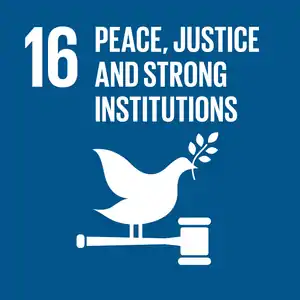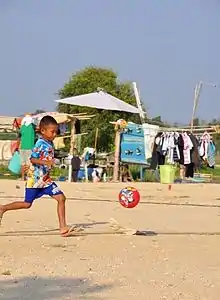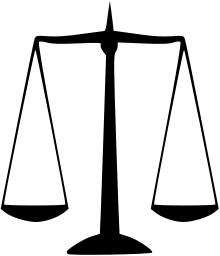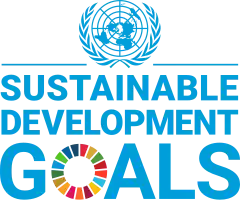Sustainable Development Goal 16
Sustainable Development Goal 16 (SDG 16 or Global Goal 16) is about "peace, justice and strong institutions." One of the 17 Sustainable Development Goals established by the United Nations in 2015, the official wording is: "Promote peaceful and inclusive societies for sustainable development, provide access to justice for all and build effective, accountable and inclusive institutions at all levels".[1] The Goal has 12 targets to be achieved by 2030. Progress towards targets will be measured by 23 indicators.
| Sustainable Development Goal 16 | |
|---|---|
 | |
| Mission statement | "Promote peaceful and inclusive societies for sustainable development, provide access to justice for all and build effective, accountable and inclusive institutions at all levels" |
| Commercial? | No |
| Type of project | Non-Profit |
| Location | Global |
| Owner | Supported by United Nation & Owned by community |
| Founder | United Nations |
| Established | 2015 |
| Website | sdgs |
The goal has ten "outcome targets": Reduce violence; protect children from abuse, exploitation, trafficking and violence; promote the rule of law and ensure equal access to justice; combat organized crime and illicit financial and arms flows, substantially reduce corruption and bribery; develop effective, accountable and transparent institutions; ensure responsive, inclusive and representative decision-making; strengthen the participation in global governance; provide universal legal identity; ensure public access to information and protect fundamental freedoms. There are also two "means of achieving targets": Strengthen national institutions to prevent violence and combat crime and terrorism; promote and enforce non-discriminatory laws and policies.[2]
Reducing violent crime, sex trafficking, forced labor, and child abuse are clear global goals. The International Community values peace and justice and calls for stronger judicial systems that will enforce laws and work toward a more peaceful and just society.[1]
Background
The Sustainable Development Goals are a collection of 17 global goals set by the United Nations. The broad goals are interrelated though each has its own targets to achieve. The SDGs cover a broad range of social and economic development issues. These include poverty, hunger, health, education, climate change, gender equality, Water supply, sanitation, energy, urbanization, environment and social justice.[3] The SDGs include an emphasis on the importance of achieving progress on peaceful and inclusive societies, access to justice and rule of law, and effective, accountable and inclusive institutions.[4]
Targets, indicators and progress
SDG 16 has twelve targets and 24 indicators. Two of the targets specify their end year (by 2030) while the others do not have a specific end year. Below is the list of all the targets with a short version and a long version of the titles.[4][5]

No data is available yet for the following indicators: 16.4.1, 16.4.2, 16.6.2, 16.7.1, 16.7.2, 16.b.1.[5] For all the other indicators, data and world maps are available to visualize progress.[5]
Target 16.1: Reduce violence everywhere
Long title: "Significantly reduce all forms of violence and related death rates everywhere."[4]
This target has four indicators:[5]
- Indicator 16.1.1 Number of victims of intentional homicide per 100,000 population, by sex and age.
- Indicator 16.1.2 Conflict-related deaths per 100,000 population, by sex, age and cause.
- Indicator 16.1.3 Proportion of population subjected to (a) physical violence, (b) psychological violence and (c) sexual violence in the previous 12 months.
- Indicator 16.1.4 Proportion of population that feel safe walking alone around the area they live.
Target 16.2: Protect children from abuse, exploitation, trafficking and violence

Long title: "End abuse, exploitation, trafficking and all forms of violence against and torture of children."[4]
This target has three indicators:[5]
- Indicator 16.2.1: Proportion of children aged 1–17 years who experienced any physical punishment and/or psychological aggression by caregivers in the past month.
- Indicator 16.2.2: Number of victims of human trafficking per 100,000 population, by sex, age and form of exploitation.
- Indicator 16.2.3: Proportion of young women and men aged 18–29 years who experienced sexual violence by age 18.
One target is to see the end to sex trafficking, forced labor, and all forms of violence against and torture of children. However, reliance on the indicator of "crimes reported" makes monitoring and achieving this goal challenging.[6] For instance, 84 percent of countries have no or insufficient data on violent punishment of children.[7] Of the data available, it is clear that violence against children by their caregivers remains pervasive: Nearly 8 in 10 children aged 1 to 14 are subjected to violent discipline on a regular basis (regardless of income), and no country is on track to eliminate violent discipline by 2030.[7]
By 2017, the UN could report progress on detecting victims of trafficking. More women and girls than men and boys were victimized, yet the share of women and girls has slowly declined (see also violence against women). In 2004, 84 percent of victims were females and by 2014 that number had dropped to 71 percent. Sexual exploitation numbers have declined, but forced labor has increased.[7]

Target 16.3: Promote the rule of law and ensure equal access to justice
The full text of Target 16.3: "Promote the rule of law at the national and international levels and ensure equal access to justice for all."[4]
This target has three indicators:[5]
- Indicator 16.3.1: Proportion of victims of violence in the previous 12 months who reported their victimization to competent authorities or other officially recognized conflict resolution mechanisms.
- Indicator 16.3.2: Unsentenced detainees as a proportion of overall prison population.
- Indicator 16.3.3: Proportion of the population who have experienced a dispute in the past two years and who accessed a formal or informal dispute resolution mechanism, by type of mechanism.
Target 16.4: Combat organized crime and illicit financial and arms flows
The full text of Target 16.4: "By 2030, significantly reduce illicit financial and arms flows, strengthen the recovery and return of stolen assets and combat all forms of organized crime."[4]
The target has two indicators:[5]
- Indicator 16.4.1: Total value of inward and outward illicit financial flows (in current United States dollars).
- Indicator 16.4.2: Proportion of seized, found or surrendered arms whose illicit origin or context has been traced or established by a competent authority in line with international instruments.
Target 16.5: Substantially reduce corruption and bribery
The full text of Target 16.5: "Substantially reduce corruption and bribery in all their forms."[4]
The target has two indicators:[5]
- Indicator 16.5.1: Proportion of persons who had at least one contact with a public official and who paid a bribe to a public official, or were asked for a bribe by those public officials, during the previous 12 months.
- Indicator 16.5.2: Proportion of businesses that had at least one contact with a public official and that paid a bribe to a public official, or were asked for a bribe by those public officials during the previous 12 months.
With regards to bribery: Data from 38 countries over the past decade suggest that high-income countries have the lowest prevalence of bribery (an average of 3.7 per cent), while lower-income countries have high levels of bribery when accessing public services (22.3 per cent).[8]
Target 16.6: Develop effective, accountable and transparent institutions
The full text of Target 16.6: "Develop effective, accountable and transparent institutions at all levels."[4]
The target has two indicators:[5]
- Indicator 16.6.1: Primary government expenditures as a proportion of original approved budget, by sector (or by budget codes or similar).
- Indicator 16.6.2: Proportion of population satisfied with their last experience of public services.
Target 16.7: Ensure responsive, inclusive and representative decision-making
The full text of Target 16.7: "Ensure responsive, inclusive, participatory and representative decision-making at all levels."[4]
The target has two indicators:[5]
- Indicator 16.7.1: Proportions of positions in national and local institutions, including (a) the legislatures; (b) the public service; and (c) the judiciary, compared to national distributions, by sex, age, persons with disabilities and population groups.
- Indicator 16.7.2: Proportion of population who believe decision-making is inclusive and responsive, by sex, age, disability and population group.

Target 16.8: Strengthen the participation in global governance
The full text of Target 16.8: "Broaden and strengthen the participation of developing countries in the institutions of global governance.".[4] The target has a single indicator
Indicator 16.8.1 is the "Proportion of members and voting rights of developing countries in international organizations".[5]
Target 16.9: Provide universal legal identity
The full text of Target 16.9: "By 2030, provide legal identity for all, including birth registration.".[4] It has one indicator:
Indicator 16.9.1 is the "Proportion of children under 5 years of age whose births have been registered with a civil authority, by age".
Target 16.9 also targets universal legal identity and birth registration, ensuring the right to a name and nationality, civil rights, recognition before the law, and access to justice and social services. With more than a quarter of children under 5 unregistered worldwide as of 2015, about 1 in 5 countries will need to accelerate progress to achieve universal birth registration by 2030.[10]
Target 16.10: Ensure public access to information and protect fundamental freedoms
The full text of Target 16.10: "Ensure public access to information and protect fundamental freedoms, in accordance with national legislation and international agreements."[4]
The target has two indicators:[5]
- Indicator 16.10.1 Number of verified cases of killing, kidnapping, enforced disappearance, arbitrary detention and torture of journalists, associated media personnel, trade unionists and human rights advocates in the previous 12 months.
- Indicator 16.10.2 Number of countries that adopt and implement constitutional, statutory and/or policy guarantees for public access to information.
Target 16.a: Strengthen national institutions to prevent violence and combat crime and terrorism
The full text of Target 16.a: "Strengthen relevant national institutions, including through international cooperation, for building capacity at all levels, in particular in developing countries, to prevent violence and combat terrorism and crime."[4] It has one indicator
Indicator 16.a.1 is the "Existence of independent national human rights institutions in compliance with the Paris Principles".[5]
Target 16.b: Promote and enforce non-discriminatory laws and policies
The full text of Target 16.b: "Promote and enforce non-discriminatory laws and policies for sustainable development."[4] It has one indicator
Indicator 16.b.1 is the "Proportion of population reporting having personally felt discriminated against or harassed in the previous 12 months on the basis of a ground of discrimination prohibited under international human rights law".[5]
Custodian agencies
Custodian agencies are responsible for monitoring and reporting of indicators:[11]
- Indicator 16.1.1: United Nations Office on Drugs and Crime (UNODC) and World Health Organisation (WHO).
- Indicator 16.1.2: Office of the UN High Commissioner for Human Rights (OHCHR)
- Indicator 16.1.3 and 16.1.4: United Nations Office on Drugs and Crime (UNODC)
- Indicator 16.2.1 and 16.2.3: United Nations Children's Emergency Fund (UNICEF)
- Indicators 16.2.2, 16.3.2 and 16.5.1 is: United Nations Office on Drugs and Crime (UNODC)
- Indicator 16.4.1: United Nations Office on Drugs and Crime (UNODC), and United Nations Conference on Trade and Development (UNTAD)
- Indicator 16.4.2: United Nations Office on Drugs and Crime (UNODC), and United Nations Office for Disarmament Affairs
- Indicator 16.5.2: World Bank (WB) and United Nations Office on Drugs and Crime (UNODC).
- Indicator 16.6.1: World Bank (WB)
- Indicator 16.6.2 and for two indicators under Target 16.7 is: United Nations Development Programme (UNDP).
- Indicator 16.8.1: Department of Economic and Social Affairs-Financing for Development Office (DESA/FFDO)
- Indicator 16.9.1: Department of Economic and Social Affairs-Statistics Division (DESA/UNSD) and United Nations Children's Emergency Fund (UNICEF).
- Indicator 16.10.1, 16.a.1 and 16.b.1: Office of the UN High Commissioner for Human Rights (OHCHR).
- Indicator 16.10.2: United Nations Educational, Scientific, and Cultural Organization-Institute for Statistics (UNESCO-UIS)
Monitoring and progress
High-level progress reports for all the SDGs are published in the form of reports by the United Nations Secretary General. The most recent one is from April 2020.[8][12]
The International Programme for the Development of Communication is responsible for the follow-up of the SDG 16 through indicators 16.10.1 and 16.10.2.[13] Every two years, a report containing information from the Member States on the status of judicial inquiries on each of the killings condemned by UNESCO is submitted to the IPDC Council by UNESCO's Director-General.[14][15] The journalists safety indicators is a tool developed by UNESCO which, according to UNESCO's website, aims on mapping the key features that can help assess the safety of journalists, and help determine whether adequate follow-up is given to crimes committed against them.[16] The IPDC Talks also allow the Programme to raise awareness on the importance of access to information.[17] The IPDC also monitors and reports on access to information laws around the world through the United Nations Secretary-General global report on follow-up to SDGs.
Challenges
Impact of Covid-19 pandemic
The global COVID-19 pandemic is predicted to increase the frequency of conflicts as countries blame others for their situation.[18] Its also expected that global peace and security will be threatened with over 60% countries risking the spread of COVID-19 in prisons due to overcrowding.[19]
Links with other SDGs
The Sustainable Development Goals are not taken as being completely independent one from the other, but rather as being closely linked. In this way, media development enhances freedom of speech, peace, but also contributes to sustainability, poverty eradication and human rights.[20] Fostering peace and inclusive societies can help reduce inequalities (SDG10) and help economies prosper (SDG8).[21] The 2012 outcome document of the United Nations Summit on the 2030 Agenda considers that sustainable development can not be achieved without building peaceful, just and inclusive societies and addressing issues of corruption, poor governance, insecurity and injustice.[3]
Organizations
UN organizations
The United Nations Development Programme is the United Nations global development network which is concerned with SDG 16. Hence, the Program focuses on democratic governance and peace building.[22] The UNDP also works on conflict prevention by empowering youth, especially women. Also, they aim at supporting the frameworks and structure and by acting as mediators.[23]
UNESCO has revealed diverse contributions to improve the scope of SDG 16 including:
- UNESCO's communication and information sector is responsible for targets 16.3 (access to justice), 16.5 (anti-corruption and transparent and accountable institutions). It aims to: "foster intercultural dialogue, culture of peace and non-violence, and prevent violent extremism through global citizenship education; support free, independent and pluralistic media, ensure the safety of journalists; protect cultural and natural heritage, strengthen governance systems for culture and enhance fundamental freedoms."[24][25]
- Preventing violent extremism is a way to promote, in official wording, a "culture of peace and non-violence" for UNESCO. The Organization aims to prevent violent extremism by using education as a tool to strengthen global citizenship, by mobilizing youth, women and other stakeholders to take actions, online and offline, to prevent and respond to violent extremism and radicalization on the Internet.[26]
- Freedom of speech - UNESCO, as the United Nations agency with the specific mandate to promote "the free flow of ideas by word and image", supports a free, independent and pluralistic media in print, broadcast and on the Internet.[20]
NGOs and foundations
- Justice Rapid Response is the only global facility that provides rapidly deployable experts in a wide range of highly specialized fields to assist with investigations in situations where war crimes, genocide, crimes against humanity, and serious human rights violations may have occurred.[27]
- The international peacebuilding organisation Saferworld have pioneered a localization approach for SDG16+ – in an attempt to promote national ownership of commitments made under SDG16 and within the wider 2030 Agenda to build peaceful, just and inclusive societies.[28]
- The anti-corruption non-governmental organization Transparency International monitors corruption in over a hundred countries and aims to "gives voice to the victims and witnesses of corruption" and "stop the abuse of power, bribery and secret deals". The Organization launched the Corruption Perceptions Index in 1995.[29]
- Reporters Without Borders is a French "independent" non-governmental organization with consultative status at the United Nations. The NGO promotes freedom of information and safety of journalists. RSF Advocates worldwide for international and national legislation on freedom of information and protection of journalists.[30] It has put together the 2018 World Press Freedom Index as a basis to analyze the state of freedom of expression.[31]
- The World Wide Web Foundation is an association that promotes digital equality, access to information, and the open web as a "public good and a basic right". It advocates for public policies in over a dozen countries.[32]
References
- United Nations official website on SDGs: https://sustainabledevelopment.un.org/sdg16
- United Nations (2017) Resolution adopted by the General Assembly on 6 July 2017, Work of the Statistical Commission pertaining to the 2030 Agenda for Sustainable Development (A/RES/71/313)
- United Nations (2015) Resolution adopted by the General Assembly on 25 September 2015, Transforming our world: the 2030 Agenda for Sustainable Development (A/RES/70/1)
- United Nations (2017) Resolution adopted by the General Assembly on 6 July 2017, Work of the Statistical Commission pertaining to the 2030 Agenda for Sustainable Development (A/RES/71/313)
- Ritchie, Roser, Mispy, Ortiz-Ospina. "Measuring progress towards the Sustainable Development Goals." (SDG 16) SDG-Tracker.org, website (2018)
- "SDG16 Data Initiative 2017 Global Report". SDG16 Report. 16 November 2017. Archived from the original on 23 July 2017. Retrieved 16 November 2017.
- "Progress for Every Child in the SDG Era" (PDF). UNICEF. Retrieved 2 April 2018.
- United Nations Economic and Social Council (2020) Progress towards the Sustainable Development Goals Report of the Secretary-General, High-level political forum on sustainable development, convened under the auspices of the Economic and Social Council (E/2020/57), 28 April 2020
- "Our World in Data". SDG Tracker.
- "Progress for Every Child in the SDG Era" (PDF). UNICEF. Retrieved 2 April 2018.
- "United Nations (2018) Economic and Social Council, Conference of European Statisticians, Geneva," (PDF). United Nations (SDG 16) Custodian Agencies" (PDF)" (PDF). UNECE. Retrieved 23 September 2020.
- "High-level Political Forum - Sustainable Development Knowledge Platform". United Nations. United Nations. Retrieved 8 September 2020.
- Division, United Nations Statistics. "SDG Indicators – SDG Indicators". United Nations.
- "UN Plan of Action on the safety of journalists and the issue of impunity". unesdoc.unesco.org. 2016. Retrieved 3 November 2020.
- "International Programme for the Development of Communication - Areas of Work". UNESCO. 21 April 2017. Retrieved 3 November 2020.
- For international-level indicators see: http://unesdoc.unesco.org/images/0026/002608/260892E.pdf For national-level indicators see: http://unesdoc.unesco.org/images/0026/002608/260893E.pdf
- "About the IPDCtalks". UNESCO.
- Leal Filho, Walter; Brandli, Luciana Londero; Lange Salvia, Amanda; Rayman-Bacchus, Lez; Platje, Johannes (1 July 2020). "COVID-19 and the UN Sustainable Development Goals: Threat to Solidarity or an Opportunity?". Sustainability. 12 (13): 5343. doi:10.3390/su12135343. ISSN 2071-1050. S2CID 225547434.
- "The sustainable development goals report 2020" (PDF).
- "Fostering Freedom of Expression". UNESCO.
- "Background of the Sustainable Development Goals". UNDP.
- See official website: http://www.undp.org/content/undp/en/home/democratic-governance-and-peacebuilding.html
- "Conflict prevention – UNDP". UNDP.
- http://unesdoc.unesco.org/images/0024/002477/247785e.pdf
- "Communication and Information – United Nations Educational, Scientific and Cultural Organization". UNESCO.
- http://unesdoc.unesco.org/images/0026/002603/260382e.pdf
- See official website: https://www.justicerapidresponse.org/
- Putting SDG16+ into practice: https://www.saferworld.org.uk/multimedia/putting-sdg16-into-practice
- See official website: https://www.transparency.org/
- "RSF". Bienvenue sur le site de Reporter sans frontières – Reports Without Borders.
- "RSF Index 2018: Hatred of journalism threatens democracies". Reports Without Borders.
- "About". World Wide Web Foundation.
